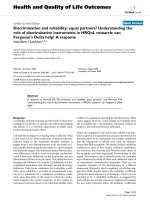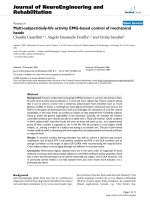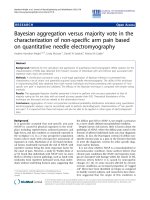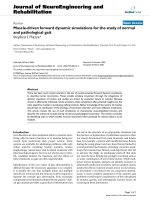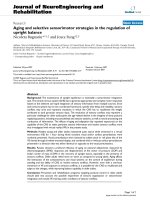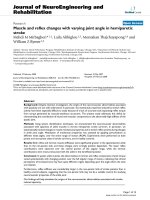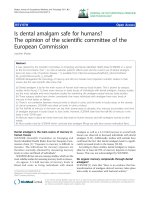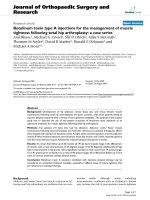báo cáo hóa học:" HIV and concurrent sexual partnerships: modelling the role of coital dilution" ppt
Bạn đang xem bản rút gọn của tài liệu. Xem và tải ngay bản đầy đủ của tài liệu tại đây (305.78 KB, 9 trang )
RESEARCH Open Access
HIV and concurrent sexual partnerships:
modelling the role of coital dilution
Larry Sawers
1*
, Alan G Isaac
1
and Eileen Stillwaggon
2
Abstract
Background: The concurrency hypothesis asserts that high prevalence of overlapping sexual partnerships explains
extraordinarily high HIV levels in sub-Saharan Africa. Earlier simulation models show that the network effect of
concurrency can increase HIV incidence, but those models do not account for the coital dilution effect (non-
primary partnerships have lower coital frequency than primary partnerships).
Methods: We modify the model of Eaton et al (AIDS and Behavior, September 2010) to incorporate coital dilution
by assigning lower coital frequencies to non-primary partnerships. We parameterize coital dilution based on the
empirical work of Morris et al (PLoS ONE, December 2010) and others. Following Eaton et al, we simulate the daily
transmission of HIV over 250 years for 10 levels of concurrency.
Results: At every level of concurrency, our focal coital-dilution simulation prod uces epidemic extinction. Our
sensitivity analysis shows that this result is quite robust; even modestly lower coital frequencies in non-primary
partnerships lead to epidemic extinction.
Conclusions: In order to contribute usefully to the investigation of HIV prevalence, simulation models of
concurrent partnering and HIV epidemics must incorporate realistic degrees of coital dilution. Doing so dramatically
reduces the role that concurrency can play in accelerating the spread of HIV and suggests that concurrency can not
be an important driver of HIV epidemics in sub-Saharan Africa. Alternative explanations for HIV epidemics in sub-
Saharan Africa are needed.
Background
The concurrency hypothesis asserts that the high preva-
lence of overlapping sexual partnerships - kno wn as con-
currency or multiple concurrent partnering - explains the
extraordinarily high levels of HIV in sub-Saharan Africa.
For the hypothesis to be valid, concurrency must be espe-
cially effective in spreading HIV. To assess the implica-
tions of concurrency for the spread of HIV, researchers
have turned to formal models.
The present paper describes a logica l and empirical
error - the failure to incorporate coital dilution -
embedded in many well-known sexual-network models
that purport to demonstrate a critical role for concur-
rency in spreading HIV [1-8]. We develop a simple,
empirically grounded modification of a model recently
published by Eaton, Hallett and G arnett [9]. The cor-
rected model does not generate any sustainable epidemic
of HIV, even at implausibly high levels of concurrency.
Our results support the view that concurrency cannot be
a principal driver of sub-Saharan Africa’s HIV epidemics.
Evidence of coital dilution
Coital dilution is t he reduction in per-partner coital fre-
quency that accompanies the acquisition of additional
partners. A person who acquires additional partners may
very well increase his or her total coital frequency, but coi-
tal dilution means that his or her average per-partner coi-
tal frequency will decli ne with the acquisition of each
additional partner. Relevant evidence is not plentiful, but
it confirms the existence of coital dilution. Morris, Epstein
and Wawer [10] report survey evidence from Rakai,
Uganda, and they find that reported coital frequencies in
secondary partnerships are less than one-quarter those in
primary partnerships. Harrison et al studied youth aged 15
to 24 years in KwaZulu-Natal, South Africa [11], and pre-
sent the proportion of respondents who reported sex in
the previous week, month and year with their two most
* Correspondence:
1
Department of Economics, American University, Washington DC, USA
Full list of author information is available at the end of the article
Sawers et al. Journal of the International AIDS Society 2011, 14:44
/>© 2011 Sawers et al; licensee BioMed Central Ltd. This is an Open Access article distributed under the terms of the Creative Commons
Attribution License ( which permits u nrestricted use, distribution, and reproduction in
any medium, provided the original work is properly cited.
recent partners. Sexual contact was far less frequent in
secondary partnerships.
Of women interviewed in the Lesotho 2009 Demo-
graphic and Health Survey (DHS), 2.3% reported overlap-
ping partners six months prior to the interview
(calculated by the authors using a dataset supplied by
MEASURE DHS - ICF Macro). Of those, nearly all (96%)
reported only two partners in the pre vious year. Among
those women, 41% reported at least weekly sex (52 or
more times a year) with their most recent partner, but
only 12% reported coital frequency that high with their
second most recent partner. Only 9% reported six or
fewer coital acts in the previous year with their most
recent partner, b ut more than half reported sex that
infrequently with their second most recent partner.
Gourvenec et al [12] report on sexually experienced
women aged 15 to 34 years i n Botswana. Seventy percent
of those with on-going concurrent partnerships reported
sex with only one partner in the prev ious month. (There
is also evidence of coital dilution in the US [10,13].)
A substantial literature on fertility and polygyny in sub-
Saharan Africa presumes or confirms coital dilution in
polygynous marriages in the region [14-16]. Many concur-
rent partnerships, even though not sanctioned by law, reli-
gion or custom, function as though they were polygynous
unions, so that literature is relevant to a broader discus-
sion of concurrency. Coital dilution is part of the reason
why polygyny appears to protect populations from HIV
[17-19]. Reniers and Tfaily’s study of 20 countries in sub-
Saharan Africa reports that “compared to women in
monogamous unions, women in polygynous unions report
lower coital frequency in all but one of the countries” [19].
Stewart et al find that in the Central African Republic
reported coital frequency was lower among wome n in
polygynous marriages than among monogamous women
and that “coital frequency decreased significantly as the
number of co-wives increased” ([20] page 531).
Coital dilution is also intuitively plausible or even
obvious. Long-distance migration for extended periods,
which is common in sub-Saharan A frica and often cited
as a source of concurrency in the region [21,22], can lead
to second partnerships that fall within the standard defi-
nition of concurrency. Nevertheless, those partnerships
also resemble serial monogamy: the partner in town or at
the mines only replaces the coition that the migrant
might have had with a partner at home. In addition, com-
mon sense tells us that simply multiplying the number of
sex acts in proportion to the number of additional part-
ners would surpass many people’ s organizationa l and
time-budgeting skills [13].
Concurrency, coital dilution and HIV
There are two possible mechanisms by which concur-
rency can affect the spread of HIV: a network effect and
a coital dilution effect. To determine the impact of dif-
ferences in the level of concurrency o n HIV transmis-
sion, one must hold constant anything else that might
affect HIV incidence, including the number of partner-
ships in the population. More concurrency means that
there are more partnerships that overlap, not more part-
nerships. An increase in the number of overlapping
partnerships in a popu lation of a given size with a fixed
number of partnerships necessarily implies an increase
in the number of individuals who have no p artner.
Thus, concurrency concentrates sexual activity in a sub-
set of the population. That concentration, other things
equal, could be expected to accelerate the spread of
HIV. We call that the “network effect”.
At the same time, concurrency reduces total coition in
a population because of coital dilution, which is the
lower average per-partnership coital frequency in the
population at higher levels of concurrency. If the number
of partnerships in a population is constant and the aver-
age coital frequency in those partnerships falls, then total
coition must also fall. The lower the average coital fre-
quency, other things equal, the slower is the sexual
spread of HIV since there are fewer sex acts by which the
infection can be transmitted. We call that the “coital dilu-
tion effect”. The strength of the coital dilution effect on
HIV, of course, depends on how rapidly average per-part-
ner coital frequency falls with any increase in the share of
overlapping partnerships among total partnerships.
Whether the network effect or the coital dilution effect is
stronger cannot be determined a priori.
Modelling concurrency
Our model of HIV transmission in sexual networks is an
adaptation of the model developed by Eaton et al [9],
which is a modified version of Morri s and Kretzschmar’s
model [2]. E aton et al replace Morris and Kretzschmar’s
invariant (and excessively high) transmission rate with
one that varies with the stage of infectio n, relying on the
calculations of Hollingsworth et al [23], who rework data
from a study by Wawer et al [24]. (Eaton et al also incor-
porate vital dynamics, such as births and deaths, allowing
them to model epidemics for 250 years, not just for the
five years considered by Morris and Kretzschmar.)
Eaton et al find that “with staged tra nsmission and up
to 8% [point prevalence] of individuals having concur-
rent partnerships, HIV fails to spread” [9]. That finding
seriously undermines the concurrency hypothesis, since
no country-level survey in sub-Saharan Africa using cur-
rently accepted questionnaire designs [25] has found
point prevalence of concurrency for all adult s higher
than 8% (see Table One in [26]). Rates of concurrency
exceeding 8% can be found in subpopulations within
sub-Saharan African countries, but the concurrency
Sawers et al. Journal of the International AIDS Society 2011, 14:44
/>Page 2 of 9
hypothesis concerns differences between countries or
groups of countries, not selected sub-national groups.
Coital frequency in precursor models
Agent-based simulation models of sexual-network
dynamics and HIV (such as Morris and Kretzschmar and
Eaton et al) specify a daily risk of transmission in each
sero-discordant partnership.Modelsofthisgenrehave
no per-act transmission rate or coital frequency para-
meters per se and make no explicit assumptions about
the value of those variables. Nevertheless, the daily risk of
infection is conceptually the product of a per-act trans-
mission rate and coital frequency. By assuming a d aily
risk of infection (either fixed or stage-specific) that is
common to all partnerships, Morris and Kretzschmar
and Eaton et al have implicitl y assumed that coital fre-
quency is the same in all partnerships (or in all partner-
ships at any given stage of infection). See Additional
File 1 for a fuller discussion of this issue.
Morris and Kretzschmar assume a fixed 0.05 daily
infection risk, for which they offer no explanation and
provide no citation [2]. Eaton et al’ s daily stage-specific
risk of infection is Hollingsworth et al’sstage-specific
annual risk of infection divided by 365. A brief explana-
tion of how they determined that annual risk of infection
may be useful to the reader. To measure per-act trans-
mission risk, one must first specify a period during which
transmission takes place and then count both the number
of sex acts and the number of seroconversions during
that period. Dividing the number of seroconversions by
the number of sex acts yields the per-act transmission
rate, and dividing the number sex acts by time yields coi-
tal frequency. Hollingsworth et al argue that measuring
the frequency of sex acts is subject to substantial report-
ing error, which produces a corresponding error in the
per-act transmission rate [23].
Modellers, however, do not need to know the value of
either of those error-prone variables. They need only a
time-dependent risk of infectio n, which can be estimated
directly from data on seroconversions over a specified
period. Accordingly, Hollingsworth et al, and therefore
Eaton et al never specify a value for coital frequency.
Instead, they use a daily stage-specific risk of infection.
Nevertheless,usingthesamerateforallpartnershipsis
problematic in the presence of concurrency since it pre-
sumes the same (though unspecified) coital frequency at
each stage of infection for both primary and non-pri mary
partnerships. That presumption of the same coital fre-
quency, however, is inconsistent with the evidence for
the existence of coital dilution.
Additionally, Hollingsworth et al estimated their infec-
tion risk using data from Wawer et al [24], who studied
transmission only between partners who “reported that
they were monogamous (defined as having only 1 sex
partner during the period of observation)” (page 1404).
Eaton et al’s daily risk of infection is thus derived from
data only from primary partnerships in which both part-
ners reported no other partner. Nevertheless, they assign
the same daily stage-specific risk of infection to both
monogamous and concurrent partnerships. That is
appropriate only if monogamous and concurrent partner-
ships have the sa me coital frequency, which - give n the
evidence for coital dilution - they do not.
We do not have any direct measure of the daily risk of
infection in non-primary partnerships, but the evidence
shows that coital frequencies in non-primary partner-
ships are much lo wer than in p rimary partnerships. We
respond to this evidence by distinguishing primary and
non-primary partnerships and assuming lower daily risk
of infection in non-primary partnerships.
Methods
Our sole objective in this article is to demonstrate the
impact of incorporating coital dilution into a model of
sexual netw ork dynamics and HIV. We therefore select a
baseline model [9] that is a substantial improvement on
the model created by pioneers in the field [2]. Our model
successfully replicates the baseline results under t he
assumption of no coital dilution. We then offer a focal
simulation with 75% coital dilution, along with a sensitiv-
ity analysis.
Critical assumptions
As noted, modelling the effects of concurrency per se
requires holding constant the number of partnerships in
the modelled population as one changes the level of con-
currency. In other words, model ling an increase in the
level of concurrency only reapportions partnerships within
the population such that some individuals gain additional
part nerships, leaving others with fewer partners or none.
We follow that established practice, as do both Eaton et al
[9] and Morris and Kretzschmar [2]. The latter say that
their model is “carefully structured to ensure that concur-
rency is not c onfounded with a simple increase in the
number of partnerships”. Of course, a model that also
increased the number of partnerships would generate a
more rapid spread of HIV [3], but it could not disentangle
the separate effects of increased sexual partnering in gen-
eral from concurrency specifically.
Holding constant the number of partnerships is also
consistent with evidence on the prevalence of partnering
in sub-Saharan Africa. Supporters of the concurrency
hypothesisarguethatconcurrencyismoreprevalentin
the region than in countries with much lower HIV preva-
lence. They acknowledge, however, that the prevalence of
multiple partnering in the previous year or in a lifetime is
not especially high in sub-Saharan Africa [27,28], a find-
ing that is confirmed by numerous surveys (for example,
Sawers et al. Journal of the International AIDS Society 2011, 14:44
/>Page 3 of 9
see [29]). Survey data also show that the proportion of
adults with ev en one sexual part ner is much lower in
sub-Saharan Africa than in the US or Europe. For exam-
ple, the prevalence of adult men reporting any female
sexual partner in the previous year is 78.9% in the US
and 96.3% (unweighted average) in 10 European coun-
tries, but only 67.1% (weighted average) in 18 sub-
Sahar an African countries (Table Two in [30], Tables 5.2
and 5.6 in [31], and Table Five in [32]). Modelling that
allows the number of partnerships to rise as the level of
concurrency is increased does not reflect the sub-Saharan
African reality, which is characterized by a lower preva-
lence of partnering.
A second critical assumption follows from the first and
has to do with the frequency of sex acts in the modelled
population. If coital dilution is introduced into a model
in which the number of partnership s is fixed, then coital
frequency in the population as a whole must fall. That
follows from the definition of coital dilution, which is the
decline in average per-partner coital frequency with the
acquisition of additional partners, that is, with an
increase in concurrency. Goodreau urges holding con-
stant the number of sex acts “so that observed epidemic
differences do not simply reflect changes in coital acts”
[33]. The only way to accept Goodreau’s advice without
increasing the number of partnerships is to disregard coi-
tal dilution.
At issue is whether or not coital dilution is an essential
empirical dimension of con currency. We argue that it is.
As we have seen, the evidence in support of coital dilu-
tion is not abundant, but is unanimous, and concurrent
partnering without coital dilution in any actual society is
implausible. Goodreau effectively counsels us to ignore
the empirical reality of concurrency and examine only
the network effect of concurrency without the coital dilu-
tion effect. Ignoring coital dilution by holding total coi-
tion constant thus obscures rather than clarifies the role
of conc urrency in spre ading HIV, a nd produces no
results of interest or consequence.
Parameter values and algorithm configuration
Other than incorporating coital dilution, our simulation
procedures replicate those of Eaton et al.SeeTable1
for parameter values used in our simulations. We simu-
late the daily sexual behaviours, infections and deaths in
a population of 10,000 men and 10,000 women for 250
years. We run 100 replicates of each simulation sce-
nario, recording the mean HIV preval ence on each day.
We initialize the HIV epidemic by infecting 1% of men
and 1% of women. Our focal simulation assumes 75%
coital dilution, and we include a sensitivity analysis that
explores various degrees of coital dilution.
We compare our results with those of Eaton et al,
which we replicate with 0% coital dilution. We consider
the same 10 levels of concurrency, including serial
monogamy, used by Eaton et al. We measure the level
of concurrency by point preva lence. The maximum level
of concurrency considered is 14%, at which point about
30% of those with partners have more than one partner
and two-thirds of all par tnerships in the population ar e
concurrent. That is the maximum level considered by
Eaton et al and by Morris and Kretzschmar [2]. It is not
far from the theoretical maximum level of concurrency
at which point all partnerships are concurrent.
Modifying Eaton et al’ s model to encompass coital
dilution requires changing both their algorithm and
some parameter values: we mus t introduce lower daily
risks of infection in non-primary partnerships, and we
must distinguish algorithmically between primary and
non-primary partnerships. We assign differential infec-
tion risks in primary and non-primary partnerships
based on data from Morris, Epstein and Wawer’ssurvey
in Rakai, Uganda, in 1993 and 1994 [10], which reports
median annual coition in primary and secondary part-
nerships for men and women separately. Based on those
data, our focal simulation makes the assumption that
coital frequency in secondary partnerships is 25% of that
in primary partnerships, which is somewhat above the
observed percentage in Morris et al. Lacking empirical
evidence on coital frequencies in third, fourth and fifth
partnerships, we assume identical coital frequencies in
all non-primary partnerships.
Upon partnership formation, our model assigns part-
nership status as follows: if neither partner has a primary
partner, a new partnership is the primary partnership. All
other partnerships are designated as non-primary. Once
designated as primary or non-primary, that designation
remains until the partnership dissolves. Any rule o f this
sort is arbitrary. We do not believe that different decision
rules would lead to important changes in our results, but
to hedge against that possibility, we test for robustness by
varying the difference in i nfection risk between primary
and secondary partnerships.
Results
In the context of the literature concerned with the effect
of concurrency on HIV prevalence, the results of our
focal simulation (the first one shown in Table 2; see also
Figure 1) appear startling: the higher the level of con-
currency, the more quickly HIV prevalence falls, and the
sooner the epidemic reaches extinction. At the highest
level of concurrency, HIV prevalence falls by nearly half
in 10 years, as deaths from AIDS outpace incident infec-
tions. In 30 years, preval ence falls by 90%. The process
of extinction is slower with serial monogamy. It takes 30
years for HIV prevalence to fall by half and nearly 100
years to fall by 90%. At intermediate levels o f concur-
rency, the epidemic paths lie between those two
Sawers et al. Journal of the International AIDS Society 2011, 14:44
/>Page 4 of 9
extremes. Our results co nfirm the importance of coital
dilution in understan ding the impact of concurrency on
HIV epidemics. Nevertheless, for reasons we will dis-
cuss, we believe that even our simulations overstate the
importance of concurrency in spreading HIV.
We present simulations to test the robustness of our
results by successively modelling lower degrees of coital
dilution. Table 2 reports the results of simulations with
coital dilution set at 55%, 35%, 25% and 15%. We also
include a set of simulations in the last rows of Table 2
with no coital dilution, that is, when daily infection risks
in non-primary partnerships are identical to those in
primary partnerships. With no coital dilution, our
results reproduce those of Eaton et al. (Compare our
Figure 2 to Figure 1(b) in [9].)
With 55% coital dilution, just as at 75%, HIV epi-
demics progress to extinction more rapidly at higher
levels of concurrency than at lower levels. By reducing
coital dilution to the 35% level, we find that concurrency
slows rather than accelerates the process of epidemic
extinction, but the epidemic still moves to extinction at
all levels of concurrency. When we reduce coital dilu-
tion to the 25% level (so that daily infection risk in non-
primary partnerships is only 25% less than in primary
partnerships), we see a spreading epidemic at the high-
est level of concurrency (when 14% of the population
has at least one con current partner), but epidemics
moving to extinction at lower levels of concurrency.
When we further reduce coital dilution to the 15%
level, we finally produce outcomes resembling those of
Eaton et al. Even at that minimal level, however, coital
dilution substantially moderates the impact of concur-
rency on HIV prevalence. For example, Eaton et al
found that in 25 years, HIV prevalence rises from 1% to
2.42% at the highest level of concurrency (14% point
prevalence). With only 15% less sex in non-primary
partnerships, however, our model produces in 25 years
only one-third the increase in HIV prevalence that
Eaton et al found. Thus, even at implausibly high levels
of concurrency, any considered degree of coital dilution
produces substantial erosion in the ability of concur-
rency to spread HIV.
Another way to look at these results is to find how
high concurrency must be to avoid epidemic extinction.
The percentages in Table 2 in boldface type are ones
without epidemic extinction and are located in the
lower right corner of the table. Eaton et al found that
with point prevalence of concurrency below 8%, HIV
epidemics become extinct. Recall that no nationally
representative survey in Africa in the past 20 years
using currently accepted questionnaire design has found
point prevalence of concurrency as high as 8%. We find
that by assuming only a 15% reduction in daily infection
risks for non-primary partnerships, that threshold rises
from 8% to 11% point p revalence. When coital dilution
reaches 25%, any point prevalence of concurrency lower
Table 1 Parameters and parameter values used in simulations
a
Parameter Parameter Value
Number of males in population 10,000
Number of females in population 10,000
Partnership formation rate 0.01
Partnership dissolution probability 0.005/day
Mean partnership duration 200 days
Primary partnership transmission probability
during primary infection 0.00732/day
during asymptomatic infection 0.00029/day
during symptomatic infection 0.00208/day
during severe AIDS infection 0.0/day
Non-primary partnership transmission probability
in focal simulation 75% less than in primary partnerships
in sensitivity analysis 55%, 35%, 25%, 15%, 0% smaller
Duration of primary infection 88 days
Duration of asymptomatic infection 3054 days
Duration of symptomatic infection 274 days
Duration between infection and death 3723 days
Number of male seed infections 100 (1%)
Number of female seed infections 100 (1%)
a
This table is adapted from Eaton et al, Table One [9] by specifying different transmission probabilities for primary and non-primary partnerships. Primary
partnership transmission probabilities are taken directly from [9].
Sawers et al. Journal of the International AIDS Society 2011, 14:44
/>Page 5 of 9
Table 2 HIV prevalence at different degrees of concurrency with 75%, 55%, 35%, 25%, 15%, and 0% coital dilution at
0 to 250 years
Time 0% Concurrency 3% Concurrency 7% Concurrency 10% Concurrency 12% Concurrency 14% Concurrency
75% coital dilution (daily risk of infection in non-primary partnerships is 25% of primary partnership risk)
0 years 1.00% 1.00% 1.00% 1.00% 1.00% 1.00%
10 years 0.81% 0.72% 0.64% 0.58% 0.52% 0.51%
25 years 0.56% 0.41% 0.29% 0.23% 0.17% 0.16%
50 years 0.29% 0.15% 0.08% 0.04% 0.03% 0.02%
100 years 0.09% 0.02% 0.01% 0.00% 0.00% 0.00%
250 years 0.00% 0.00% 0.00% 0.00% 0.00% 0.00%
55% coital dilution (daily risk of infection in non-primary partnerships is 45% of primary partnership risk)
0 years 1.00% 1.00% 1.00% 1.00% 1.00% 1.00%
10 years 0.81% 0.75% 0.71% 0.70% 0.68% 0.70%
25 years 0.57% 0.45% 0.40% 0.36% 0.35% 0.37%
50 years 0.30% 0.21% 0.16% 0.13% 0.12% 0.14%
100 years 0.09% 0.04% 0.03% 0.01% 0.01% 0.02%
250 years 0.00% 0.00% 0.00% 0.00% 0.00% 0.00%
35% coital dilution (daily risk of infection in non-primary partnerships is 65% of primary partnership risk)
0 years 1.00% 1.00% 1.00% 1.00% 1.00% 1.00%
10 years 0.81% 0.80% 0.81% 0.82% 0.85% 0.92%
25 years 0.56% 0.55% 0.55% 0.59% 0.64% 0.80%
50 years 0.30% 0.29% 0.28% 0.33% 0.41% 0.64%
100 years 0.09% 0.07% 0.07% 0.10% 0.18% 0.38%
250 years 0.00% 0.00% 0.00% 0.01% 0.02% 0.08%
25% coital dilution (daily risk of infection in non-primary partnerships is 75% of primary partnership risk)
0 years 1.00% 1.00% 1.00% 1.00% 1.00% 1.00%
10 years 0.81% 0.81% 0.84% 0.89% 0.97% 1.06%
25 years 0.56% 0.57% 0.62% 0.71% 0.86% 1.13%
50 years 0.29% 0.32% 0.35% 0.51% 0.71% 1.21%
100 years 0.09% 0.10% 0.14% 0.25% 0.54% 1.41%
250 years 0.00% 0.00% 0.01% 0.03% 0.20% 1.80%
15% coital dilution (daily risk of infection in non-primary partnerships is 85% of primary partnership risk)
0 years 1.00% 1.00% 1.00% 1.00% 1.00% 1.00%
10 years 0.81% 0.86% 0.88% 0.96% 1.03% 1.18%
25 years 0.56% 0.63% 0.70% 0.89% 1.09% 1.49%
50 years 0.29% 0.38% 0.51% 0.75% 1.21% 2.27%
100 years 0.09% 0.13% 0.25% 0.58% 1.48% 4.20%
250 years 0.00% 0.01% 0.03% 0.21% 2.25% 8.26%
No coital dilution (daily risk of infection in non-primary partnerships is the same as primary partnership risk)
0 years 1.00% 1.00% 1.00% 1.00% 1.00% 1.00%
10 years 0.81% 0.87% 0.96% 1.08% 1.21% 1.42%
25 years 0.57% 0.67% 0.86% 1.19% 1.64% 2.42%
50 years 0.30% 0.42% 0.73% 1.38% 2.61% 5.29%
100 years 0.10% 0.18% 0.52% 1.71% 5.37% 12.42%
250 years 0.00% .02% 0.19%
2.72% 10.02% 15.70%
Sawers et
al. Journal
of the International AIDS Society 2011, 14:44
/>Page 6 of 9
than 14% produces epidemic extinction. At any higher
degree of coital dilution, HIV epidemics progress to
extinction at all considered levels of concurrency.
Discussion
Our simulation includes both the network and the coital
dilution effects o f concurrency on HIV incidence, and it
shows that heterosexual HIV epidemics quickly become
extinct even at high simulated levels of concurrency.
Researchers who model the effects of concurrency on
HIV epidemic dynamics have ignored or inadequately
accounted for coital dilution. In response to the available
empirical evidence on coital frequency in non-primary
partnerships, we distinguish between primary and non-
primary partnerships by assigning lower stage-specific
daily infection risk in non-primary partnerships. The
availableevidence,whileadmittedly thin, accords with
our intuition that people do not typically increase their
total sexual activity in proportion to the number of part-
ners. Drawing on the work of Morris, Epstein and
Wawer [10], our focal simulation assumes 75% coital
dilution (so that daily infection risks in non-primary part-
nerships are 25% of those in primary partnerships).
At that level of coital dilution, epidemics progress
rapidly to extinction at all considered levels of concur-
rency. The higher t he level of concurrency, the more
rapid is the progression to extinction. Eaton et al find
that HIV epidemics progress to extinction when point
prevalence of concurrency is 8% or low er. We find that
with even modest degrees of coital dilution, that thresh-
old quickly rises. Our sensitivity analysis demonstrates
that even with only a 35% reduction in daily infection
risks in non-primary partnerships due to coital dilution,
HIV epidemics progress to extinc tion at all considered
rates of concurrency.
Other researchers hav e also emphasized the impor-
tance of coital frequ ency in concurrent partnerships in
explaining regional variations in HIV prevalence. Reniers
and co-authors [17-19] argue that polygynous marriages
protect against HIV at the population level, in part due
to coital dilution. Our results show that in the presence
of coital dilution, all concu rrent partnerships, even if not
sanctioned by law, religion, or custom, can be protective
against HIV, not just polygynous marriages.
Although our results show a far smaller effect of con-
currency on HIV epidemics than other modellers have
found, we suspect that our simulations actually overstate
the importance of concurrency. First, Additional File 2
exp lores additional reasons why Eaton et al’s model may
substantially overstate concurrency’s impact on HIV pre-
valence. Since our model is equivalent to theirs except
for the addition of coital dilution, our results correspond-
ingly overstate concurrency’s role. Second, we assume in
the model that daily infection risks are the same in all
non-primary partnerships (rather than falling as succes-
sive partners are added) and that adding a second partner
does not reduce coital frequency in a primary partner-
ship. We suspect that neither of those assumptio ns is
correct, in which case, our simulations overstate average
coital frequency for all concurrent partnerships and our
results systematically understate the coital dilution effect.
Thus, our findings would overstate the impact of concur-
rency on HIV.
Limitations of the data also raise the possibility that our
focal simulation might understate t he impact of concur-
rency on HIV epidemics. Our estimate that coital fre-
quency in non-primary partnersh ips is at least 75% lower
than in primary partnerships is based on respondents’
statements about the number of sex acts in those part-
nerships in the previous year [10]. If non-primary part-
nerships were more likely than primary partnerships to
have begun and/or ended in that year, and if for some
reason the data were not adjusted to account for the
shor ter duration, then some of the difference in reported
Figure 1 HIV prevalence at different levels of concurrency from
0 to 250 years with coital dilution of 75%.
Figure 2 HIV prevalence at different levels of concurrency from
0 to 250 years with no coital dilution.
Sawers et al. Journal of the International AIDS Society 2011, 14:44
/>Page 7 of 9
median annual coition could have resulted from shorter
average partnership duration rather than lower coital fre-
quency during partnerships. Note that the mean overlap
of partnerships in the different gender/location groups in
Morris et al was just over two years in two groups,
aroun d five years in three groups, and over eight years in
the remaining group. Given those extensive overlaps, the
problem of different partnership duration is unlikely to
have produced serious bias. Nevertheless, our sensitivity
analysis shows that our results are robust even if our
focal simulation substantially overestimates the degree of
coital dilution.
Conclusions
Coital dilution means that as levels of concurrency rise in
a population and other sexua l behaviour s do not change,
the number of sex acts in the population declines. That is
so because individuals on average do not simply scale up
their sexual activity as they take on additional partners.
The falling number of sex acts reduces the number of
times that HIV can be transmitted and consequently slows
the spread of the virus. When even implausibly modest
degr ees of coital dilution are built into a model of sexual
networks and HIV epidemic dynamics, modelled HIV epi-
demics move rapidly to extinction. Our work shows that
in order to contribute usefully to the investigation of HIV
prevalence and sexual network dynamics, simulation mod-
els must incorporate realistic degrees of coital dilution.
These findings have two implications. First, in contrast
to the prior simulation literature, we have shown that
there is no basis for featuring concurrency per se (as
opposed to multiple partnerships in general) in any HIV-
prevention message in sub-Saharan Africa or anywhere
else. Second, our results indicate that concurrency cannot
explain the extraordinarily high preva lence of HIV in
sub-Saharan Africa, even if it could be shown that con-
currency was more prevalent there. (See [26], which
shows that concurrency is not especially prevalent in the
region.) Evidence does not support the notion that differ-
ences in sexual behaviour are enough to explain Africa’s
hyper-epidemics of HIV [27-29]. Researchers should look
for other drivers of the HIV epidemics in Africa.
Additional material
Additional file 1: The assumption of constant coital frequency [34-
38].
Additional file 2: Overstating the importance of concurrency in
Eaton et al [39].
Acknowledgements
We wish to thank Jeffrey Eaton for answering our many questions and for
providing the C++ and R code for his model, which is also downloadable as
supplementary material to his article. We also thank Georges Reniers, whose
comment on an early draft of this article spurred us to make improvements
to the manuscript. The anonymous reviewers also made helpful comments.
The authors received no funding to carry out this research. An abstract of an
early version of this paper, entitled “Reducing concurrency for HIV-
Prevention: Modelling behavioural risk and coital dilution”, appears in the
conference programme of the 6
th
IAS Conference on HIV Pathogenesis,
Treatment, and Prevention held on 17-20 July 2011 in Rome, Italy, at http://
pag.ias2011.org/abstracts.aspx?aid=3846.
Author details
1
Department of Economics, American University, Washington DC, USA.
2
Department of Economics, Gettysburg College, Gettysburg, PA, USA.
Authors’ contributions
LS, AI and ES collaborated in posing the research topic, developing the
modelling strategy, parameterizing the model, and drafting the manuscript.
AI wrote the Python simulation code and managed the simulations. All
authors have read and approved the final manuscript.
Authors’ information
Larry Sawers is Professor of Economics at American University. Alan G Isaac
is Associate Professor of Economics at American University. Eileen
Stillwaggon is Professor of Economics and Harold G. Evans-Eisenhower
Professor at Gettysburg College.
Competing interests
The authors declare that they have no competing interests.
Received: 13 April 2011 Accepted: 13 September 2011
Published: 13 September 2011
References
1. Goodreau S, Cassels S, Kasprzyk D, Montano D, Greek A, Morris M:
Concurrent partnerships, acute infection and HIV epidemic dynamics
among young adults in Zimbabwe. AIDS and Behavior 2010.
2. Morris M, Kretzschmar M: Concurrent partnerships and the spread of HIV.
AIDS 1997, 11:641-648.
3. Morris M, Kretzschmar M: A microsimulation study of the effect of
concurrent partnerships on the spread of HIV in Uganda. Mathematical
Population Studies 2000, 8:109-133.
4. Kretzsch mar M, Morris M: Measures of concurrency in networ ks and
the spread of infectious disease. Mathematical Bioscience 1996,
133:165-195.
5. Doherty IA, Shiboski S, Ellen JM, Adimora AA, Padian NS: Sexual bridging
socially and over time: A simulation model exploring the relative effects
of mixing and concurrency on viral sexually transmitted infection
transmission. Sexually Transmitted Diseases 2006, 33:368-373.
6. Ghani AC, Garnett GP: Risks of acquiring and transmitting sexually
transmitted diseases in sexual partner networks. Sexually Transmitted
Diseases 2000, 27:579-587.
7. Korenromp EL, Vliet CV, Bakker R, Vlas SJD, Habbema JDF: HIV spread and
partnership reduction for different patterns of sexual behaviour - a
study with the microsimulation model STDSIM. Mathematical Population
Studies 2000, 8:135-173.
8. Johnson LF, Dorrington RE, Bradshaw D, Pillay-VanWyk V, Rehle TM: Sexual
behaviour patterns in South Africa and their association with the spread
of HIV: Insights from a mathematical model. Demographic Research 2009,
21:289-340.
9. Eaton J, Hallett T, Garnett G: Concurrent sexual partnerships and primary
HIV infection: A critical interaction. AIDS and Behavior 2010, 15:687-692.
10. Morris M, Epstein H, Wawer M: Timing is everything: International
variations in historical sexual partnership concurrency and HIV
prevalence. PLoS ONE 2010, 5:1-8.
11. Harrison A, Cleland J, Frohlich J: Young people’s sexual partnerships in
KwaZulu-Natal, South Africa: Patterns, contextual influences, and HIV
risk. Studies in Family Planning 2008, 39:295-308.
12. Gourvenec D, Taruberekera N, Mochaka O, Kasper T: Multiple concurrent
partnerships among men and women aged 15-34 in Botswana, baseline
study, December 2007. Gaborone, Botswana 2007.
Sawers et al. Journal of the International AIDS Society 2011, 14:44
/>Page 8 of 9
13. Blower SM, Boe C: Sex acts, sex partners, and sex budgets: Implications
for risk factor analysis and estimation of HIV transmission probabilities.
Journal of Acquired Immune Deficiency Syndromes 1993, 6:1347-1352.
14. Josephson SC: Does polygyny reduce fertility? American Journal of Human
Biology 2002, 14:222-232.
15. Muhsam HV: Fertility of polygamous marriages. Population Studies 1956,
10:3-16.
16. Pebley A, Mbugua W: Polygyny and fertility in sub-Saharan Africa. In
Reproduction and social organization in sub-Saharan Africa. Edited by:
Lesthaeghe R. Berkeley: University of California Press; 1989:338-364.
17. Reniers G, Tfaily R: Polygyny and HIV in Malawi. Demographic Research
2008, 19:1811-1830.
18. Reniers G, Watkins S: Polygyny and the spread of HIV in sub-Saharan
Africa: A case of benign concurrency. AIDS 2010, 24:299-307.
19. Reniers G, Tfaily R: An inquiry into the mechanisms linking polygyny,
partnership concurrency and HIV transmission in sub-Saharan Africa Princeton
University, Office of Population Research: Princeton; 2010.
20. Stewart H, Morison L, White R: Determinants of coital frequency among
married women in Central African Republic: The role of female genital
cutting. Journal of Biosocial Science 2002, 34:525-539.
21. Mah TL, Halperin DT: Concurrent sexual partnerships and the HIV
epidemics in Africa: Evidence to move forward. AIDS and Behavior 2010,
14:11-16.
22. Muchini B, Benedikt C, Gregson S, Gomo E, Mate R, Mugurungi O,
Magure T, Campbell B, Dehne K, Halperin D: Local perceptions of the
forms, timing and causes of behavior change in response to the AIDS
epidemic in Zimbabwe. AIDS and Behavior 2010, 15:487-498.
23. Hollingsworth TD, Anderson R, Fraser C: HIV-1 transmission, by stage of
infection. Journal of Infectious Diseases 2008, 198:687-693.
24. Wawer MJ, Gray RH, Sewankambo NK, Serwadda D, Li X, Laeyendecker O,
Kiwanuka N, Kigozi G, Kiddugavu M, Lutalo T, Nalugoda F, Wabwire-
Mangen F, Meehan MP, Quinn TC: Rates of HIV-1 transmission per coital
act, by stage of HIV-1 infection, in Rakai, Uganda. Journal of Infectious
Diseases 2005, 191:1403-1409.
25. UNAIDS Reference Group on Estimates MaP: Consultation on concurrent
sexual partnerships UNAIDS; Nairobi, Kenya; 2009 [ />Publications/Concurrency%20meeting%20recommendations_Final.pdf].
26. Sawers L, Stillwaggon E: Concurrent sexual partnerships do not explain
the HIV epidemics in Africa: A systematic review of the evidence. Journal
of the International AIDS Society 2010, 13:13-34.
27. Wellings K, Collumbien M, Slaymaker E, Singh S, Hodges Z, Patel D, Bajos N:
Sexual behaviour in context: A global perspective. Lancet 2006,
368:1706-1728.
28. Cleland J, Ferry B, Caraël M: Summary and conclusions. In Sexual behaviour
and AIDS in the developing world. Edited by: Cleland J, Ferry B. London:
Taylor and Francis for the World Health Organization; 1995:208-228.
29. Stillwaggon E: AIDS and the ecology of poverty New York: Oxford University
Press; 2006.
30. Adimora AA, Schoenbach VJ, Doherty IA: Concurrent sexual partnerships
among men in the United States. American Journal of Public Health 2007,
97:2230-2237.
31. Leridon H, van Zessen G, Hubert M: The Europeans and their sexual
partners. In Sexual behaviour and HIV/AIDS in Europe: Comparisons of
national surveys. Edited by: Hubert M, Bajos N, Sandfort T. London: UCL
Press; 1998:165-196.
32. Mishra V, Bignami-Van Assche S: Concurrent sexual partnerships and HIV
infection: Evidence from national population-based surveys, in DHS Working
paper USAID; 2009 [ />33. Goodreau S: A decade of modelling research yields considerable
evidence for the importance of concurrency: A response to Sawers and
Stillwaggon. Journal of the International AIDS Society 2011, 14:1-7.
34. Downs A, De Vincenzi I: Probability of heterosexual transmission of HIV:
Relationship to the number of unprotected sexual contacts. Journal of
Acquired Immune Deficiency Syndromes 1996, 11:388-395.
35. Padian NS, Shiboski SC, Jewell NP: The effect of number of exposures on
the risk of heterosexual HIV transmission. Journal of Infectious Diseases
1990, 161:883-887.
36. Kaplan EH: Modeling HIV infectivity: Must sex acts be counted? Journal of
Acquired Immune Deficiency Syndromes 1990, 3:55-61.
37. Shiboski SC, Padian NS: Epidemiologic evidence for time variation in HIV
infectivity. Journal of Acquired Immune Deficiency Syndromes and Human
Retrovirology 1998, 19:527-535.
38. Nagelkerke N, de Vlas SJ, Jha P, Luo M, Plummer FA, Kaul R: Heterogeneity
in host HIV susceptibility as a potential contributor to recent HIV
prevalence declines in Africa. AIDS 2009, 23:125-130.
39. Pilcher CD, Tien HC, Eron JJ Jr, Vernazza PL, Leu S, Stewart PW, Goh L,
Cohen MS: Brief but efficient: Acute infection and the sexual
transmission of HIV. Journal of Infectious Diseases 2004, 189:1785-1792.
doi:10.1186/1758-2652-14-44
Cite this article as: Sawers et al.: HIV and concurrent sexual
partnerships: modelling the role of coital dilution. Journal of the
International AIDS Society 2011 14:44.
Submit your next manuscript to BioMed Central
and take full advantage of:
• Convenient online submission
• Thorough peer review
• No space constraints or color figure charges
• Immediate publication on acceptance
• Inclusion in PubMed, CAS, Scopus and Google Scholar
• Research which is freely available for redistribution
Submit your manuscript at
www.biomedcentral.com/submit
Sawers et al. Journal of the International AIDS Society 2011, 14:44
/>Page 9 of 9


